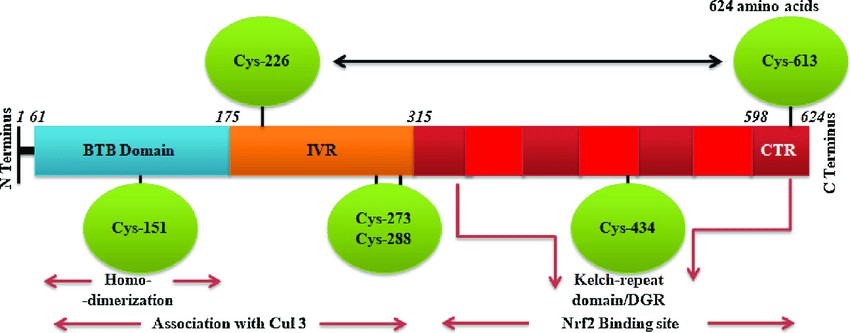What is KEAP1 Protein?
The KEAP1 protein, an acronym for Kelch-like ECH-associated protein 1, is a crucial protein discovered in the realm of molecular biology.
Ishii and colleagues introduced the KEAP1 protein to the scientific community in 1999. They identified KEAP1 as a negative regulator of NF-E2-related factor 2 (NRF2) while conducting research to understand the NRF2-ARE (Antioxidant Response Element) pathway, responsible for protecting cells from oxidative stress.
The KEAP1 gene, which codes the KEAP1 protein, is located on chromosome 19p13.2 in humans. It spans about 31.48 kilobases, containing five exon regions primarily responsible for coding the protein.

Structurally, the KEAP1 protein consists of approximately 624 amino acids, exhibiting a three-domain structure. It includes an N-terminal broad-complex, Tramtrack, Bric-a-brac (BTB) domain responsible for homodimerization and interaction with Cul3-based E3 ligase complex, a central intervening region (IVR), and a C-terminal Kelch domain that interacts directly with NRF2.
Function of KEAP1 protein
The primary function of KEAP1 is to suppress NRF2 to maintain cellular homeostasis under normal non-stressed conditions. It plays a critical role in cell defense mechanisms, especially against oxidative and electrophilic attacks, by regulating the expression of genes under the Antioxidant Response Elements (ARE). When undesired stimuli affect the cell, NRF2 disassociates from KEAP1, leading to its stabilization and translocation into the nucleus where it promotes the transcription of antioxidant genes. Thus, the KEAP1/NRF2 pathway's proper functioning is crucial for cellular health.
Further analysis of the KEAP1 protein unraveled its association with diverse signal transduction pathways. Besides the NRF2-ARE pathway, KEAP1 modulates other pathways such as mTOR, PI3K/Akt, and Notch signaling pathways, playing distinct roles in redox homeostasis, inflammatory responses, and cellular differentiation and proliferation.
KEAP1 protein related diseases
The dysregulation of KEAP1 protein or mutation in the KEAP1 gene is implicated in several diseases, most notably in the field of oncology. Almost 20% of non-small-cell lung cancer cases exhibit mutations in the KEAP1 gene. Similarly, KEAP1 mutations have also been identified in patients with gallbladder cancer, skin cancer, and liver cancer. Besides cancer, abnormal KEAP1/NRF2 activity also leads to chronic obstructive pulmonary disease (COPD) and idiopathic pulmonary fibrosis.
Given its essential role in the regulation of oxidative stress and implication in numerous diseases, KEAP1 protein holds potential implications in biomedicine. Researchers are actively exploring therapeutic strategies targeting the KEAP1/NRF2/ARE pathway. These strategies involve using KEAP1 inhibitors for the treatment of diseases driven by oxidative stress. In cancer therapy, the utilization of compounds to restore the NRF2-KEAP1 pathway's normal function displays promising results by reducing tumor growth and enhancing the efficacy of chemotherapeutical agents. Furthermore, the use of KEAP1 as a biomarker for clinical development also holds immense potential.
In summary, KEAP1 protein, since its discovery, has profoundly redefined our understanding of cellular defense mechanisms. Its unique protein structure and critical role in antioxidative pathways underline its importance in maintaining cellular health. However, its dysregulation can also trigger a multitude of diseases. But on a brighter note, it paves the way for innovative therapeutic strategies and holds immense potential in the biomedical field.
Our Featured Products
| Cat.No. | Product Name | Species | Source (Host) | Tag |
|---|---|---|---|---|
| KEAP1-547H | Recombinant Human KEAP1 protein, His&GST&Avi-tagged | Human | Insect Cells | His&GST&Avi |
| KEAP1-652H | Recombinant Human KEAP1 protein, MYC/DDK-tagged | Human | HEK293 | Myc/DDK |
| KEAP1-188H | Recombinant Human KEAP1, His-GST tagged | Human | Insect Cell | Fc/His |
| KEAP1-2185H | Recombinant Human KEAP1 Protein (1-624 aa), His-tagged | Human | Yeast | His |
| KEAP1-9852HFL | Recombinant Full Length Human KEAP1 protein, Flag-tagged | Human | Mamanlian cells | Flag |
| KEAP1-830H | Recombinant Human KEAP1 Protein, His-tagged | Human | E.coli | His |
Reference
- Mohan, Shikha & Gupta, Damodar. (2018). Crosstalk of toll-like receptors signaling and Nrf2 pathway for regulation of inflammation. Biomedicine & Pharmacotherapy. 108. 1866-1878. 10.1016/j.biopha.2018.10.019.

